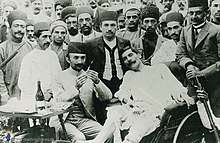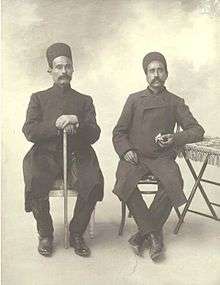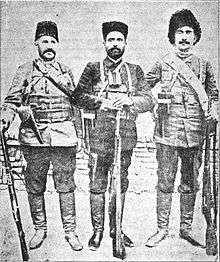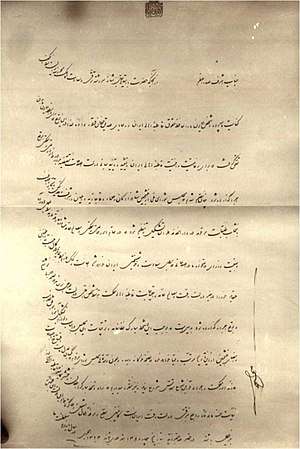Persian Constitutional Revolution
The Persian Constitutional Revolution (Persian: مشروطیت Mashrūtiyyat, or انقلاب مشروطه[10] Enghelāb-e Mashrūteh), also known as the Constitutional Revolution of Iran, took place between 1905 and 1911.[11] The revolution led to the establishment of a parliament in Persia (Iran) during the Qajar dynasty.[11][12]
The revolution opened the way for fundamental change in Persia, heralding the modern era. It was a period of unprecedented debate in a burgeoning press, and new economic opportunities. Many groups fought to shape the course of the revolution, and all segments of society were in some way changed by it. The old order, which King Nassereddin Shah Qajar had struggled for so long to sustain, was finally replaced by new institutions, new forms of expression, and a new social and political order.
King Mozaffar ad-Din Shah Qajar signed the 1906 constitution shortly before his death. He was succeeded by Mohammad Ali Shah, who abolished the constitution and bombarded the parliament in 1908 with Russian and British support. This led to another pro-constitutional movement. The constitutionalist forces marched to Tehran, forced Muhammad Ali Shah's abdication in favor of his young son Ahmad Shah Qajar, and re-established the constitution in 1909.
The 1921 Persian coup d'état (Persian: کودتای ۳ اسفند ۱۲۹۹) refers to several major events which led to the establishment of the Pahlavi dynasty as Iran's ruling house in 1925. Iran's parliament amended the 1906–1907 constitution on December 12, 1925, replacing the 1797–1925 Qajar dynasty with the Pahlavi dynasty as the legitimate sovereigns of Iran.[13] The revolution was followed by the Jungle Movement of Gilan (1914-1921).
History

With the first provision signed by Muzzafir al-Din days before his death, Iran saw legislative reform vital to their goal of independence from Britain and Russia. The three main groups of the coalition seeking a constitution were the bazaar merchants, the ulama, and a small group of radical reformers. They shared the goal of ending royal corruption and ending dominance by foreign powers. According to the revolutionaries, the role of the shah was being used to keep the Qajar dynasty and other aristocrats wealthy at the expense of Iran's resources and economy. They argued that whilst Iran's oil industry was sold to the British, tax breaks on imports, exports and manufactured textiles destroyed Iran's economy (which had been supported by the bazaar merchants). Muzzafir al-Din accumulated a fortune in foreign debt while selling assets to pay interest, instead of investing in Iran. This sparked the revolt. The law gave the legislature final approval of all loans and the budget. More power was divested from the shah with the supplementary fundamental law, passed a few days later, governing the appointment of ministers; a committee of mujtahids was established to ensure that new laws abided by sharia. Despite the ulamas' efforts at independence from external dominance, Britain and Russia capitalized on Iran's weak government and signed the 1907 Anglo-Russian Convention dividing the country between them (with a neutral central zone). This constitutional period ended when the majlis in Tehran's neutral zone dissolved over the issue of equal rights for non-Muslims; Russia then invaded and captured the city. Although Iran gained a constitution, Iranian independence was not achieved by the revolts.
Background

Weakness and extravagance continued during the brief reign of Mozaffar ad-Din Shah Qajar (1896–1907), who often relied on his chancellor to manage his decentralized state. His dire financial straits caused him to sign many concessions to foreign powers on trade items ranging from weapons to tobacco. The aristocracy, religious authorities, and educated elite began demanding a curb on royal authority and the establishment of the rule of law as their concern about foreign (especially Russian) influence grew.[14] Qajar had taken large loans from Russia and Britain to pay for his extravagant lifestyle and the cost of the government; the shah financed a royal tour of Europe in 1900 by borrowing ₽22 million from Russia, using Iranian customs receipts as collateral.[15]
First protests

In 1905, protests erupted about the imposition of Persian tariffs to repay the Russian loan for Mozaffar ad-Din Shah's royal tour.[15] In December of that year, two merchants in Tehran were bastinadoed for price-gouging. The city's merchants rebelled, closing its bazaar. The clergy followed suit as a result of the alliance formed during the Tobacco Protest.
The two protesting groups sought sanctuary in a Tehran mosque, but the government entered the mosque and dispersed them. The dispersal triggered a larger movement which sought refuge at a shrine outside Tehran. The shah yielded to the demonstrators on January 12, 1906, agreeing to dismiss his prime minister and transfer power to a "house of justice" (forerunner of the Iranian parliament). The basti protesters returned from the shrine in triumph, riding royal carriages and hailed by a jubilant crowd.[15]
During a fight in early 1906, government forces killed a sayyid (a descendant of Muhammad). In a skirmish shortly afterwards, Cossacks killed 22 protesters and injured 100.[16] The bazaar again closed and the ulama went on strike, a large number taking sanctuary in the holy city of Qom. Many merchants went to the British embassy in Tehran, which agreed to shelter the basti on the grounds of the embassy.[16]
Creation of the constitution

During the summer of 1906, about 12,000 men camped in the gardens of the British embassy in what has been called a "vast open-air school of political science".[16] Demand for a parliament (majlis) began, with the goal of limiting the power of the shah. Mozaffar ad-Din Shah agreed on a parliament in August 1906, and the first elections were held that fall. One hundred fifty-six members were elected, the overwhelming majority from Tehran and the merchant class.
The National Consultative Assembly first met in October 1906. The shah was old and frail, and attending the inauguration of parliament was one of his last official acts.[15] Mozaffar ad-Din Shah's son, Muhammad Ali, was unsympathetic to constitutionalism; the shah signed the constitution (modeled on the Belgian constitution) by December 31, 1906, making his power contingent on the will of the people, and died three days later.
Aftermath
Shah Muhammad Ali, the sixth Qajar shah, came to power in January 1907. The Anglo-Russian Convention, signed in August of that year, divided Iran into a Russian zone in the north and a British zone in the south; the center of the country was neutral. The British switched their support to the shah, abandoning the constitutionalists.[15] In 1908, the shah moved to "exploit the divisions within the ranks of the reformers" and eliminate the majlis.[15] Persia tried to remain free of Russian influence through resistance (via the majlis) to the shah's policies. Parliament appointed William Morgan Shuster Persia's treasurer-general. Russia issued an ultimatum to expel Shuster and suspend the parliament, occupying Tabriz.
Notable participants
Constitutionalists
.jpg)


- Mirza Nasrullah Khan – First elected Prime Minister of Iran
- Mirza Jahangir Khan – Founder and editor of the Sur-e Esrafil newspaper
- Mirza Aqa Khan Kermani – Nationalist writer and literary critic
- Mirza Sayyed Mohammad Tabatabai
- Nikol Duman – Participated in the defense of Tabriz
- Seyed Jamal Vaez
- Hossein Ardabili – Active in Mashhad
- Aref Ghazvini
- Stepan Zorian
- Ali-Akbar Dehkhoda
- Mehdi Cont – activist in Kerman
- Sattar Khan – Revolutionary leader
- Bagher Khan – Sālār-e Melli (national chieftain)
- Mirza Kuchak Khan – Founder of a revolutionary movement based in the forests of Gilan Province
- Mirza Malkom Khan
- Khetcho – Armenian revolutionary leader
- Yeprem Khan – Armenian Iranian revolutionary leader. Wounded Sattar Khan while disarming the revolutionaries in Tehran as commander of Tehran's police force during the interim constitutionalist government.
- Arshak Gafavian – Armenian revolutionary leader
- Sardar Assad – Bakhtiari tribal leader whose forces captured Tehran in 1909
- Bibi Khanoom Astarabadi – Satirist, writer and pioneer of the Iranian women's movement
- Hassan Pirnia
- Ahmad Kasravi
- Amanollah Khan Zia' os-Soltan – aristocrat and landowner who was accused of a bomb attack on Mohammad Ali Shah and freed by British troops
- Mohammad-Taqi Bahar
- Sevkaretsi Sako
- Hassan Taqizadeh
- Mirza Abdul'Rahim Talibov Tabrizi – Intellectual and social reformer.
- Abdolhossein Teymourtash
- Abdol-Hossein Farman Farma
- Mohammad Vali Khan Tonekaboni – Leader of revolutionary forces from the northern provinces of Gilan and Mazandaran
- Howard Baskerville – American teacher who fought with the constitutionalists and was killed
- Mohammed Mosaddeq – Liberal nationalist and future prime minister
- Morteza Gholi Khan Hedayat
Monarchists
- Abdol Majid Mirza
- Sheikh Fazlollah Noori – Cleric who was hanged after the revolution
- Vladimir Liakhov – Russian colonel and commander of the Persian Cossack Brigade during the rule of Mohammad Ali Shah Qajar who shelled and besieged Parliament
Religious leaders
- Mohammad-Kazem Khorasani, constitutionalist
- Sayyed Jamal ad-Din Esfahani, constitutionalist
- Sayyed Abdullah Behbahani, constitutionalist
- Mirza Sayyed Mohammad Tabatabai, constitutionalist
- Mirza Hussein Naini, constitutionalist
- Mohammed Kazem Yazdi, anti-constitutionalist
- Sheikh Fazlollah Nuri, anti-constitutionalist
- Mirza Abutaleb Zanjani, anti-constitutionalist
See also
- Young Turk Revolution
- History of Iran
- History of the Iranian Constitutional Revolution by Ahmad Kasravi
- Intellectual movements in Iran
- Iranian Revolution of 1979
- Tobacco Protest
- List of modern conflicts in the Middle East
- Triumph of Tehran
- Secularism in Iran
- Ibn al-Sheikh
- Women in Constitutional Revolution
References
- Abrahamian, Ervand (1982). Iran Between Two Revolutions. Princeton University Press. pp. 76–77. ISBN 0-691-10134-5.
- Abrahamian, Ervand (1982). Iran Between Two Revolutions. Princeton University Press. pp. 83. ISBN 0-691-10134-5.
- Abrahamian, Ervand (1982). Iran Between Two Revolutions. Princeton University Press. pp. 81. ISBN 0-691-10134-5.
- Abrahamian, Ervand (1982). Iran Between Two Revolutions. Princeton University Press. pp. 84. ISBN 0-691-10134-5.
- Abrahamian, Ervand (1982). Iran Between Two Revolutions. Princeton University Press. pp. 97. ISBN 0-691-10134-5.
- Abrahamian, Ervand (1982). Iran Between Two Revolutions. Princeton University Press. pp. 95. ISBN 0-691-10134-5.
- Abrahamian, Ervand (1982). Iran Between Two Revolutions. Princeton University Press. pp. 91. ISBN 0-691-10134-5.
- Berberian, Houri (2001). Armenians and the Iranian Constitutional Revolution of 1905–1911. Westview Press. pp. 116–117. ISBN 978-0-8133-3817-0.
- Jack A. Goldstone. The Encyclopedia of Political Revolutions Routledge, 29 apr. 2015 ISBN 1135937583 p 245
- Tilmann J. Röder, "The Separation of Powers: Historical and Comparative Perspectives" in Rainer Grote and Tilmann J. Röder, Constitutionalism in Islamic Countries (Oxford University Press 2012), p. 321-372. The article includes an English translation of the following documents: The Fundamental Law (Qanun-e Asasi-e Mashruteh) of the Iranian Empire of 14th Dhu-‘l-Qa’dah 1324 (December 30, 1906); The Amendment of the Fundamental Law of the Iranian Empire of 29th Sha’ban 1325 (October 7, 1907).
- Amanat 1992, pp. 163-176.
- "CONSTITUTIONAL REVOLUTION". Encyclopaedia Iranica, Vol. VI, Fasc. 2. 1992. pp. 163–216.CS1 maint: ref=harv (link)
- "Pahlavi Dynasty - Dictionary definition of Pahlavi Dynasty - Encyclopedia.com: FREE online dictionary".
- W. Morgan Shuster, The Strangling of Persia, 3rd printing (T. Fisher Unwin, London, 1913), pp. 48, 119, 179. According to Shuster (p. 48), "Five days later [measured from February 1st] the Persian Minister of Finance, Saniu'd-Dawleh was shot and killed in the streets of Teheran by two Georgians, who also succeeded in wounding four of the Persian police before they were captured. The Russian consular authorities promptly refused to allow these men to be tried by the Persian Government, and took them out of the country under Russian protection, claiming that they would be suitably punished."
Mohammad-Reza Nazari. "The retreat by the Parliament in overseeing the financial matters is a retreat of democracy" (in Persian). Mardom-Salari, No. 1734, 20 Bahman 1386 AH (9 February 2008). Archived from the original on April 27, 2009. - Mackey, Sandra The Iranians : Persia, Islam and the Soul of a Nation, New York : Dutton, c1996. p.150-55
- Abrahamian, Ervand, Iran Between Two Revolutions, Princeton University Press, 1982, p. 84
Sources
- Amanat, Abbas (1992). "Constitutional Revolution i. Intellectual background". Encyclopaedia Iranica, Vol. VI, Fasc. 2. pp. 163–176.CS1 maint: ref=harv (link)
- Ahmad Kasravi, Tārikh-e Mashruteh-ye Iran (تاریخ مشروطهٔ ایران) (History of the Iranian Constitutional Revolution) (in Persian) 951 p. (Negāh Publications, Tehran, 2003), ISBN 964-351-138-3. Note: This book is also available in two volumes, published by Amir Kabir Publications in 1984. Amir Kabir's 1961 edition is in one 934-page volume.
- Ahmad Kasravi, History of the Iranian Constitutional Revolution: Tarikh-e Mashrute-ye Iran, Volume I, translated into English by Evan Siegel, 347 p. (Mazda Publications, Costa Mesa, California, 2006). ISBN 1-56859-197-7
- Mehdi Malekzādeh, Tārikh-e Enqelāb-e Mashrutyyat-e Iran (تاريخ انقلاب مشروطيت ايران) (The History of the Constitutional Revolution of Iran) in 7 volumes, published in 3 volumes (1697 pp.) (Sokhan Publications, Tehran, 2004, 1383 AH). ISBN 964-372-095-0
Further reading
- Mangol Bayat, Iran’s First Revolution: Shi’ism and the Constitutional Revolution of 1905–1909, Studies in Middle Eastern History, 336 p. (Oxford University Press, 1991). ISBN 0-19-506822-X
- Browne, Edward G., "The Persian Revolution of 1905-1909", Mage Publishers (July 1995). ISBN 0-934211-45-0
- Afary, Janet, "The Iranian Constitutional Revolution, 1906-1911", Columbia University Press. 1996. ISBN 0-231-10351-4
- Foran, John. "The Strengths and Weaknesses of Iran’s Populist Alliance: A Class Analysis of the Constitutional Revolution of 1905 - 1911", Theory and Society, Vol. 20, No. 6 (Dec 1991), pp. 795–823. JSTOR
External links
| Wikimedia Commons has media related to Constitutional Revolution, Iran. |
- Reza Jamāli in conversation with Dr Abbās Amānat, Professor of History and International and Area Studies at University of Yale, in Persian, Radio Zamaneh, August 7, 2008 (Audio recording).
- Shokā Sahrāi, Photographs of the Constitutional Revolution of Iran, in Persian, Jadid Online, 2007.
Slide Show, narrated by Dr Bāqer Āqeli, Jadid Online, 2007: (4 min 30 sec). - Constitutional Revolution of Iran
